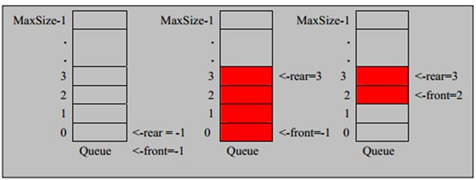定义
- 队列是一个有序列表,可以用数组或是链表来实现。
- 遵循先入先出的原则。即:先存入队列的数据,要先取出。后存入的要后取出
模拟思路
-
队列本身是有序列表,若使用数组的结构来存储队列的数据,则队列数组的声明如下图, 其中 maxSize 是该队列的最大容量
-
因为队列的输出、输入是分别从前后端来处理,因此需要两个变量 front及 rear分别记录队列前后端的下标,front 会随着数据输出而改变,而 rear则是随着数据输入而改变,如图所示
入队出队操作模拟
当我们将数据存入队列时称为”addQueue”,addQueue 的处理需要有两个步骤:
-
将尾指针往后移:rear+1 , 当 front == rear 时,队列为空
-
若尾指针 rear 小于队列的最大下标 maxSize-1,则将数据存入 rear所指的数组元素中,否则无法存入数据。rear == maxSize - 1时,队列满
注意:front指向的是队列首元素的前一个位置
实现代码
import java.util.Scanner;
public class ArrayQueueDemo {
public static void main(String[] args) {
ArrayQueue queue = new ArrayQueue(3);
Scanner scanner = new Scanner(System.in);
boolean flag = true;
while (flag){
System.out.println("输入a(add)添加数据");
System.out.println("输入g(get)取出数据");
System.out.println("输入s(show)显示所有数据");
System.out.println("输入h(head)显示头部数据");
System.out.println("输入e(exit)退出程序");
char c = scanner.next().charAt(0);
switch (c){
case 'a':
System.out.println("请输入数据");
int num = scanner.nextInt();
queue.addNum(num);
break;
case 'g':
try {
queue.getQueue();
System.out.println("取出成功");
}catch (Exception e){
System.out.println(e.getMessage());
}
break;
case 's':
queue.showQueue();
break;
case 'h':
try {
queue.headQueue();
}catch (Exception e){
System.out.println(e.getMessage());
}
break;
case 'e':
flag = false;
System.out.println("程序已退出");
break;
default:
break;
}
}
scanner.close();
}
}
class ArrayQueue{
private int maxSize;//队列的大小
private int front;//指向队列首元素的前一个位置
private int rear;//指向队列的尾元素
private int[] arr;//用数组来实现队列
//构造方法初始化
public ArrayQueue(int maxSize) {
this.maxSize = maxSize;
front = -1;//指向的是队列第一个元素的前一个位置
rear = -1;
arr = new int[maxSize];
}
/**
* 判断队列是否装满
* @return
*/
public boolean isFull(){
return rear == maxSize-1;
}
/**
* 判断队列是否为空
* @return
*/
public boolean isEmpty(){
return front == rear;
}
/**
* 为队列添加数据
* @param num
*/
public void addNum(int num){
if (isFull()){
System.out.println("队列已经满了,无法再加入数据");
return;
}
rear++;
arr[rear] = num;
}
/**
* 取出队列中的数据
* @return
*/
public int getQueue(){
if (isEmpty()){
throw new RuntimeException("队列为空,不能取出数据");
}
front++;
return arr[front]=0;
}
/**
* 显示队列的所有数据
*/
public void showQueue(){
if (isEmpty()) {
System.out.println("队列为空,没有数据");
return;
}
for (int i = 0; i<arr.length; i++){
System.out.printf("arr[%d]=%d\n",i,arr[i]);
}
}
/**
* 显示队列的头数据,注意不是取出数据
* @return
*/
public int headQueue(){
if (isEmpty()){
throw new RuntimeException("队列为空,没有数据");
}
return arr[front+1];
}
}
运行结果


注意:因先入先出的原则,front和rear最终都会在队列顶部,所以上述队列只能一次性使用,没有达到复用的效果,因此我们要用到环形队列
环形队列
思路:
- front变量含义调整:front变量指向队首元素,初值为0
- rear变量含义调整:rear变量指向队尾元素的下一个元素,初值为0。规定空出一个位置
- 队列为空的判定条件:front == rear
- 队列为满的判定条件:(rear + 1) % maxSize == front
- 队列中有效元素的个数:(rear - front + maxSize) % maxSize
- 入队和出队时,都需要让标记对maxSize取模
-
import java.util.Scanner; public class CyclicArrayQueueDemo { public static void main(String[] args) { CyclicArrayQueue queue = new CyclicArrayQueue(3); Scanner scanner = new Scanner(System.in); boolean flag = true; while (flag){ System.out.println("输入a(add)添加数据"); System.out.println("输入g(get)取出数据"); System.out.println("输入s(show)显示所有数据"); System.out.println("输入h(head)显示头部数据"); System.out.println("输入e(exit)退出程序"); char c = scanner.next().charAt(0); switch (c){ case 'a': System.out.println("请输入数据"); int num = scanner.nextInt(); queue.addNum(num); break; case 'g': try { int n = queue.getQueue(); System.out.println("取出的数是:"+n); }catch (Exception e){ System.out.println(e.getMessage()); } break; case 's': queue.showQueue(); break; case 'h': try { queue.headQueue(); }catch (Exception e){ System.out.println(e.getMessage()); } break; case 'e': flag = false; System.out.println("程序已退出"); break; default: break; } } scanner.close(); } } class CyclicArrayQueue { private int maxSize;//队列的大小 private int front;//front变量指向队首元素,初值为0 private int rear;//rear变量指向队尾元素的下一个元素,初值为0。规定空出一个位置 private int[] arr;//用数组来实现队列 public CyclicArrayQueue(int maxSize) { this.maxSize = maxSize; arr = new int[maxSize]; } /** * 判断队列是否装满 * * @return */ public boolean isFull() { return (rear + 1) % maxSize == front; } /** * 判断队列是否为空 * * @return */ public boolean isEmpty() { return front == rear; } /** * 为队列添加数据 * * @param num */ public void addNum(int num) { if (isFull()) { System.out.println("队列已经满了,无法再加入数据"); return; } arr[rear] = num; rear = (rear + 1) % maxSize; } /** * 取出队列中的数据 * * @return */ public int getQueue() { if (isEmpty()) { throw new RuntimeException("队列为空,不能取出数据"); } int value = arr[front]; front = (front + 1) % maxSize; return value; } /** * 显示队列的所有数据 */ public void showQueue() { if (isEmpty()) { System.out.println("队列为空,没有数据"); return; } for (int i = front; i < front + size(); i++) { System.out.printf("arr[%d]=%d\n", i % maxSize, arr[i % maxSize]); } } public int size() { return (rear + maxSize - front) % maxSize; } /** * 显示队列的头数据,注意不是取出数据 * @return */ public int headQueue(){ if (isEmpty()){ throw new RuntimeException("队列为空,没有数据"); } return arr[front]; } }
import java.util.Scanner;
public class ArrayQueueDemo {
public static void main(String[] args) {
ArrayQueue queue = new ArrayQueue(3);
Scanner scanner = new Scanner(System.in);
boolean flag = true;
while (flag){
System.out.println("输入a(add)添加数据");
System.out.println("输入g(get)取出数据");
System.out.println("输入s(show)显示所有数据");
System.out.println("输入h(head)显示头部数据");
System.out.println("输入e(exit)退出程序");
char c = scanner.next().charAt(0);
switch (c){
case 'a':
System.out.println("请输入数据");
int num = scanner.nextInt();
queue.addNum(num);
break;
case 'g':
try {
queue.getQueue();
System.out.println("取出成功");
}catch (Exception e){
System.out.println(e.getMessage());
}
break;
case 's':
queue.showQueue();
break;
case 'h':
try {
queue.headQueue();
}catch (Exception e){
System.out.println(e.getMessage());
}
break;
case 'e':
flag = false;
System.out.println("程序已退出");
break;
default:
break;
}
}
scanner.close();
}
}
class ArrayQueue{
private int maxSize;//队列的大小
private int front;//指向队列首元素的前一个位置
private int rear;//指向队列的尾元素
private int[] arr;//用数组来实现队列
//构造方法初始化
public ArrayQueue(int maxSize) {
this.maxSize = maxSize;
front = -1;//指向的是队列第一个元素的前一个位置
rear = -1;
arr = new int[maxSize];
}
/**
* 判断队列是否装满
* @return
*/
public boolean isFull(){
return rear == maxSize-1;
}
/**
* 判断队列是否为空
* @return
*/
public boolean isEmpty(){
return front == rear;
}
/**
* 为队列添加数据
* @param num
*/
public void addNum(int num){
if (isFull()){
System.out.println("队列已经满了,无法再加入数据");
return;
}
rear++;
arr[rear] = num;
}
/**
* 取出队列中的数据
* @return
*/
public int getQueue(){
if (isEmpty()){
throw new RuntimeException("队列为空,不能取出数据");
}
front++;
return arr[front]=0;
}
/**
* 显示队列的所有数据
*/
public void showQueue(){
if (isEmpty()) {
System.out.println("队列为空,没有数据");
return;
}
for (int i = 0; i<arr.length; i++){
System.out.printf("arr[%d]=%d\n",i,arr[i]);
}
}
/**
* 显示队列的头数据,注意不是取出数据
* @return
*/
public int headQueue(){
if (isEmpty()){
throw new RuntimeException("队列为空,没有数据");
}
return arr[front+1];
}
}
标签:队列,环形,System,int,rear,println,模拟,out
From: https://www.cnblogs.com/wyh518/p/16725753.html
